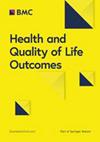EQ-5D-5L and SF-6Dv2 health utilities scores of diffuse large B-cell lymphoma patients in China
IF 3.2
2区 医学
Q1 HEALTH CARE SCIENCES & SERVICES
引用次数: 0
Abstract
This study evaluates the health-related quality of life (HRQoL) of persons with diffuse large B-cell lymphoma (DLBCL) by using EQ-5D-5L and SF-6Dv2 and compares the measurement properties of the two instruments. DLBCL patients were identified via a patient group and were surveyed using web-based questionnaires. Demographic information, socioeconomic status (SES), clinical characteristics, and EQ-5D-5L and SF-6Dv2 responses were collected and statistically described. The association between the EQ-5D-5L and SF-6Dv2 dimensions were analyzed using the Spearman's correlation coefficient, whereas the correlation of the utility scores was evaluated using Pearson's correlation coefficient. The agreement between the responses of the two instruments were examined using a Bland–Altman (B-A) plot. A one-way analysis of variance (ANOVA) was performed to compare the utility scores across subgroups in different clinical states (a t-test was used if there were two subgroups). In addition, the graded response model (GRM) was used to describe the discrimination ability and difficulty characteristics of the dimensions in the two instruments. In total, 582 valid responses were collected, among which 477 respondents were associated with initial-treatment and 105 respondents were relapsed/refractory (RR) patients. The mean (standard deviation [SD]) EQ-5D-5L and SF-6Dv2 utility scores of the DLBCL patients were 0.828 (0.222) and 0.641 (0.220), respectively. The correlation between the EQ-5D-5L and SF-6Dv2 dimensions ranged from 0.299 to 0.680, and the correlation between their utility scores was 0.787. The B-A plot demonstrated an acceptable but not strong agreement between EQ-5D-5L and SF-6Dv2 utility scores. The GRM model results indicated that all dimensions of each instrument were highly discriminating overall, but EQ-5D-5L had suboptimal discriminative power among patients with good health. Both the EQ-5D-5L and SF-6Dv2 showed valid properties to assess the HRQoL of DLBCL patients. However, utility scores derived from the two instruments had substantial difference, thereby prohibiting the interchangeable use of utilities from the two instruments.中国弥漫大 B 细胞淋巴瘤患者的 EQ-5D-5L 和 SF-6Dv2 健康效用评分
本研究通过使用 EQ-5D-5L 和 SF-6Dv2 评估弥漫大 B 细胞淋巴瘤(DLBCL)患者的健康相关生活质量(HRQoL),并比较两种工具的测量特性。弥漫性大 B 细胞淋巴瘤患者是通过一个患者团体确定的,并使用网络问卷进行了调查。收集了人口统计学信息、社会经济地位(SES)、临床特征、EQ-5D-5L和SF-6Dv2反应,并进行了统计学描述。使用斯皮尔曼相关系数分析了 EQ-5D-5L 和 SF-6Dv2 两个维度之间的关联,而使用皮尔逊相关系数评估了效用评分的相关性。使用布兰德-阿尔特曼(B-A)图检验了两种工具的响应之间的一致性。采用单因素方差分析(ANOVA)来比较不同临床状态下不同亚组的效用得分(如果有两个亚组,则采用 t 检验)。此外,还采用了分级反应模型(GRM)来描述两种工具中各维度的辨别能力和难度特征。共收集到 582 份有效答卷,其中 477 份答卷与初始治疗相关,105 份答卷与复发/难治(RR)患者相关。DLBCL患者的EQ-5D-5L和SF-6Dv2效用评分的平均值(标准差[SD])分别为0.828(0.222)和0.641(0.220)。EQ-5D-5L和SF-6Dv2维度之间的相关性从0.299到0.680不等,其效用得分之间的相关性为0.787。B-A图显示,EQ-5D-5L和SF-6Dv2效用评分之间的一致性可以接受,但并不强。GRM模型结果表明,每种工具的所有维度总体上都具有很高的区分度,但EQ-5D-5L在健康状况良好的患者中的区分度并不理想。EQ-5D-5L和SF-6Dv2都显示出评估DLBCL患者HRQoL的有效特性。但是,这两种工具得出的效用分数有很大差异,因此不能互换使用这两种工具得出的效用分数。
本文章由计算机程序翻译,如有差异,请以英文原文为准。
求助全文
约1分钟内获得全文
求助全文
来源期刊
CiteScore
7.30
自引率
2.80%
发文量
154
审稿时长
3-8 weeks
期刊介绍:
Health and Quality of Life Outcomes is an open access, peer-reviewed, journal offering high quality articles, rapid publication and wide diffusion in the public domain.
Health and Quality of Life Outcomes considers original manuscripts on the Health-Related Quality of Life (HRQOL) assessment for evaluation of medical and psychosocial interventions. It also considers approaches and studies on psychometric properties of HRQOL and patient reported outcome measures, including cultural validation of instruments if they provide information about the impact of interventions. The journal publishes study protocols and reviews summarising the present state of knowledge concerning a particular aspect of HRQOL and patient reported outcome measures. Reviews should generally follow systematic review methodology. Comments on articles and letters to the editor are welcome.

 求助内容:
求助内容: 应助结果提醒方式:
应助结果提醒方式:


